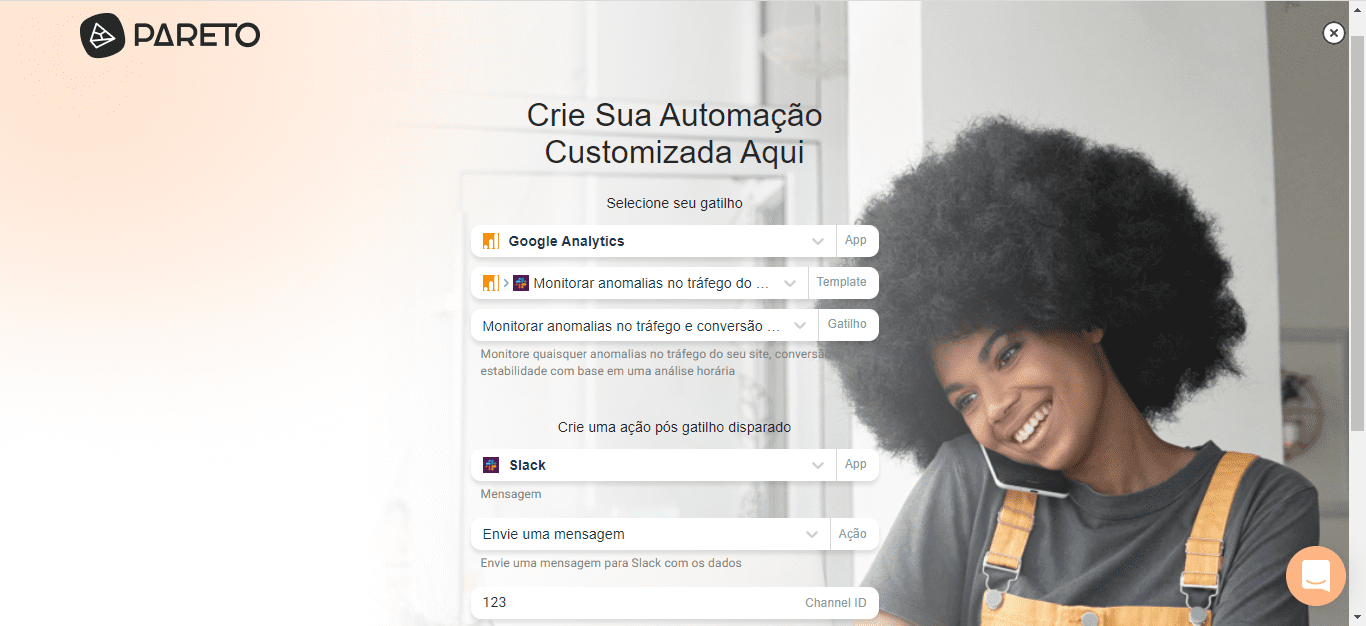The use of Robotic Process Automation (RPAs) helps to automate everything from simple to complex tasks.
In this article, we'll introduce you to what RPAs are, the main advantages of this technology and other topics related to RPAs.
What is RPA (Robotic Process Automation)?
Robotic Process Automation (RPA) is a software technology designed to automate repetitive and operational tasks in different sectors of a company.
This technology promises to revolutionize the market in the coming years. According to Grand View Research, the global RPA market is expected to grow by 32.8% per year between 2021 and 2028, reaching 13.74 billion dollars in 2028.
In practice, imagine the repetitive filling in of spreadsheets with data from a website, a task that can consume an employee's entire day.
With RPA, a software robot can perform this activity in seconds, allowing the professional to focus on more strategic or creative actions.
In addition to filling in spreadsheets, these robots can interpret codes, extract data, send responses, communicate with other systems and perform various tasks automatically and efficiently.
What is the main purpose of an RPA (Robotic Process Automation)?
In this way, the company distributes manual and operational tasks that require a lot of time from the teams to carry out. RPAs take on this role and, as a result, people are rehumanized.
As a result, employees can focus on activities that require a more sophisticated degree of creativity and strategic potential, adding more value to various aspects of the business and its customers.
How is RPA different from other automation processes?
With regard to the difference between RPAs and other automation processes, it is clear that RPAs have particularities that differentiate them from other types of tools for corporate automation purposes.
RPAs in Marketing in Numbers
With regard to the RPA landscape in the marketing sector, the context is very positive. Below you'll find some indicators that exemplify the importance of using RPAs:
- According to Deloitte92% of respondents said that RPAs met or exceeded their expectations for better compliance;
- According to Pegasystems63% of global executives said that updating RPAs is a crucial resource to adopt in the digital transformation;
- According to Forrester57% of organizations say that the use of RPAs reduces manual errors;
- According to Forresteraround 57% of executives believe that RPAs increase employee engagement.
- Based on Forrester60% of executives validate that RPAs make it possible for people to concentrate on more strategic work;
- According to research by UiPath68% of the world's employees trust that the application of automation will make them more productive.
RPAs for Marketing and Sales
Among the most common applications of RPAs are those for companies' marketing and sales departments, given the enormous potential for time savings, gains in scale and employee satisfaction.
Marketing and sales professionals have a nature geared towards creativity, strategy and relationships, skills that are overshadowed by the growing need to carry out repetitive tasks.
Pareto has developed a series of RPAs related to Marketing and Sales that allow you to increase employee productivity by up to 3 times. Get to know some of them.
RPA for Paid Media Budget Optimization
With Pareto's Omnichannel Budget Manager, the company can group paid media campaigns with the same objective and define the budget for the month.
Every day, Tess, Pareto's A.I., analyzes the performance of Google Ads and Facebook Ads campaigns and adjusts the budget automatically to maximize results.
RPA for 1-Click Optimizations
Some examples of the analysis are: blocking potentially fraudulent channels on the Google Display Network, deactivating ads with low performance on Facebook Ads, adding new keywords on Google.
RPA for Media Optimization for Pre-Qualified Leads
Monitor your form and automatically assign a score to each lead you capture. The score of qualified leads will be sent to the Google Ads and Facebook Ads platforms.
This way, you optimize your campaigns by prioritizing the highest-scoring leads, rather than considering all leads as if they were equal.
RPA for Data Integration between CRM and Paid Media
Connect to your CRM data which is centralized by the Pareto Data Warehouse, where Tess, Pareto's A.I., will evaluate the ICP and then send this information to the Google Ads and Facebook Ads platforms.
With this, you'll be able to see which campaigns, audiences and ads have contributed the most to your sales team's sales.
RPA for Integrating Data from Multiple Clients for Performance Agencies
Access projections for each account in real time in a detailed and visual way. Filter by account manager, client or customize according to your needs. Follow highlighted metrics by period. Analyze your CPA, ROAS, CPV and CPC targets. All the information structured in just a few clicks.
RPA for Inventory Integration with Paid Media
Pareto uses the e-commerce product feed to filter out products with low stock availability, temporarily removing these products from paid media.
What are the advantages of using RPAs (Robotic Process Automation)?
RPAs help companies save time, increase productivity and focus on strategic activities. Check out the main advantages:
- Time and Productivity Optimization: Automate processes, increasing productivity and freeing up professionals for strategic tasks.
- Error Reduction: reduces 57% of human errors, eliminating problems caused by exhaustion or too much information - Forrester.
- Cost reduction: avoids the need to expand the workforce for manual tasks.
- Flexibility and Integration: they integrate with different systems and adapt to different levels of tasks.
- Improved Engagement: reduces repetitive tasks, increasing engagement by 57% - Forrester.
- Improved Customer Experience: they offer fast interactions and efficient resolutions, optimizing service.
- Scalability: adapts to the company's growth, adjusting to new demands.
RPA (Robotic Process Automation) - Examples of Use
With regard to examples of the use of RPAs (Robotic Process Automation) in companies, it is possible to say that they can be implemented in various areas and processes with different functions or one in particular.
In order to make the visualization of the processes of an RPA closer to something commonly experienced, the examples below illustrate some applications:
- Report generation;
- Sending e-mail notifications with charges to defaulting customers;
- Integration of CRM with Paid Media (advertising platforms such as Google Ads and Facebook Ads);
- Analysis of fraudulent purchases in e-commerce;
- Performing complex calculations and analyses with company data;
- Managing the processing of employee performance data.
What is the relationship between RPA and Artificial Intelligence?
RPA and Artificial Intelligence (AI) are two distinct technologies, but they can be confused depending on the context. This is especially the case when AI resources are integrated into RPAs.
RPA robots are programmed to perform a series of repetitive tasks, based on rules stipulated by the user; they are not able to learn or improve their performance during the process.
In other words, if an automated task changes, the RPA robot doesn't recognize the change and needs to be programmed again to be able to perform it.
But when AI resources are integrated into the RPA, it starts to interpret behaviors, such as language processing or computer vision, and considerably increases the possibilities for decision-making.
This is because AI features mimic human behavior and complement RPA robots that replicate human actions based on rules.

5 Tips for Implementing RPA in Your Company
Given the collaborative potential that RPAs have, it is of the utmost importance that the implementation of the technology is carried out in accordance with a pre-defined plan that is aligned with the organization's objectives. The aim is to achieve maximum performance in the processes.
To achieve this, the following steps are highly recommended:
1. mapping needs
Before developing any solution, it is of the utmost importance to look at the processes your company has in place and what "pains" need to be solved. Mapping needs and requirements makes it possible to identify the main activities that need to be adjusted or included in the implementation of RPA in your company.
2. Analyzing the Best Software
At this stage, criteria and requirements must be established to help choose the most suitable RPA supplier for the organization. These parameters include technical specifications, functionalities and price.
In addition, some companies offer a few days' free trial of the product, which can be an opportunity to validate and confirm whether it will be implemented. This practice depends on the type of RPA you intend to hire.
3. Implement a Pilot
Once you've chosen the most suitable supplier, it's time to put the software into practice. To do this, you need to ensure that the company's employees are trained to use the tool. After all, there's no point in having cutting-edge technology if nobody knows how to use it, is there?
In addition, it is essential that the pilot application activities are documented in order to generate records and be analyzed. Through these statements, possible problems, needs for changes or additional requirements will be detected.
So this third stage is the time to test, make mistakes and solve them.
4. Managing the Life Cycle
Once the pilot project has been tested and adjusted to the company's reality, it's time to implement the successful solution. This is the step-by-step process for putting the established strategies and change management into practice.
5. Tess RPA Builder demo
In order to provide an incredible and practical experience, Pareto has the Tess RPA Builder within its software, where you can request an automation from among the countless predefined ones and insert business metrics and conditions.
What's more, it allows you to build customized RPAs according to your company's needs!

How do Pareto RPAs work?
With a view to robotizing processes and rehumanizing people, Pareto's RPAs come with the prospect of helping organizations' work routines. This way, human beings can focus on more strategic tasks and explore their creativity.
With this, our RPAs are based on the concept of "Time Back", so that human beings gain precious hours of their day, leaving the thousands of repetitive (but necessary) tasks to the automations.
Below, you'll learn a little more about some of our RPAs and how they can help your organization's work routine. But there are many others, as well as the possibility of creating your own RPA!
Omnichannel OBM Budget Manager
The OBM is Pareto's budget manager, which makes daily adjustments to the campaigns' daily budget. By configuring it, you can group together campaigns with the same objective and define the budget for the month.
Every day, Tess will analyze the performance of Google and Facebook campaigns and adjust the budget automatically.
With just a few clicks, you can automate the budget management of your campaigns, never miss a beat or go over your budget for the month. And you don't have to make the mistake of limiting your budget for campaigns that perform well.
Find out more about OBM and how it facilitates Google Ads and Facebook Ads Budget Management with AI in this article.
LeadScoring
LeadScoring is an RPA focused on leads. It allows you to monitor your website's forms and automatically assign a score to each lead you capture. This way, you'll be able to see the quality of the leads within the advertising platforms.
For example, a B2B company might give a higher score to contacts who fill in the form with a corporate email, and a lower score for personal emails.
Qualified leads will be sent to the Google and Facebook platforms, with the score already established. This way you can optimize your campaigns based on the qualification of the leads, giving you the possibility of optimizing by ROAS.
LeadMapper
This RPA also focuses on lead qualification. It connects the data from your CRM, which is centralized by the Pareto Data Warehouse, where Tess (Pareto's A.I.) will evaluate the ICP (Ideal Customer Profile).
It will then send this information to the Google and Facebook platforms, showing data based on final sales, improving visibility and optimization.
BI for Agencies - The Dashboard of Dreams
One of an agency's biggest challenges is to ensure that its clients' paid media management operation works as planned.
Access projections for each account in real time in a detailed and visual way; filter by account manager, client or customize according to your needs; track highlighted metrics by period; analyze your CPA, ROAS, CPV and CPC targets.
All the information you need is structured and accessible in just a few clicks.
Stock optimization
Every e-commerce business knows that managing stock of products of different sizes takes time and organization. Now, to combine this stock management with paid media ads, the dedication needs to be even greater.
Can you imagine advertising a beautiful dress but only having a PP size? The company is running the risk of serving only a few people. What's more, products with few options available naturally have a low conversion rate.
Faced with this need, we created an RPA aimed at Stock Optimization. It uses your site's product feed, adjusting it to make advertising on Google Shopping, Google Dynamic Remarketing and Facebook Catalog more precise and efficient.
Conversion API
In 2020, Facebook announced a new policy for iOS 14 and web advertisers. With it, the industry, platforms, advertisers and marketers had to adapt strategies and account structures due to the reduced capture of user data.
The Conversion API minimizes the impact of the changes by recording the main interactions, conversions and purchases made by users on the site on Facebook Ads. In this way, it solves the lack of visibility of the most effective campaigns and overcomes the challenges brought about by iOS14.
Conclusion
It is clear that the use of RPAs contributes positively to the work environment, allowing people to focus on strategic activities and increase their productivity.
With the market constantly evolving technologically, the need to optimize our time is increasing.
Tess AI, Pareto's artificial intelligence, enables various optimizations and automations in repetitive and analytical activities, giving you more time to improve campaign performance and save working time.




